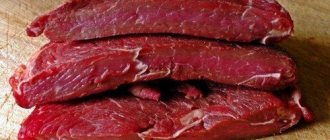Hearty jellied meat in Rus' was considered food for servants. It was prepared from the leftover meat from the table of the rich, boiling it to a thick consistency. Since the 16th century, the fashion for French dishes came to Russia, and it was then that jelly became a real festive dish. Alas, the exquisite dish could not be stored in the summer. Modern housewives have a great advantage in this regard, but not everyone knows how long homemade jellied meat can be stored in the refrigerator. The shelf life of this product varies even among manufacturers. What this is connected with and how to prolong the freshness of your favorite meat delicacy is described in the article.
In a refrigerator
It is necessary to keep jellied meat in a glass, enamel or ceramic container with a closed lid as far as possible from foods with a strong odor at a temperature not exceeding 10 degrees Celsius. According to SES standards, snacks prepared at home will be stored in the refrigerator:
- without additional products in the composition - 72 hours;
- with the addition of vegetables or herbs - 36 hours.
The expiration date of factory-made goods in a vacuum is indicated on the packaging. According to GOST, it should not exceed 10 days at a temperature of 0 to 6 degrees.
Jellied meat, prepared in large quantities, in winter, like cottage cheese, can be placed on the balcony. It is advisable that the outside temperature be around -5 degrees.
From meat
It is generally accepted that jellied meat should be prepared from the knuckle, pork legs and head. Such ingredients create a natural protective layer of frozen fat and eliminate the need to add gelatin to the composition. It is not recommended to remove this layer until consumption. Despite this, a snack made from beef or beef tongue is no less popular than from pork.
If all the rules are followed, the meat treat can remain in the refrigerator for up to 7 days.
However, it is better not to wait until the last day and eat the dish as soon as possible. Products in vacuum packaging must be consumed within the period specified by the manufacturer.
From fish
The main raw material for jellied fish is frozen fish. Fish aspic is more difficult to prepare than others, but the end result is an excellent holiday treat: pike perch is especially tasty.
The shelf life of the jelly is only 24 hours at a temperature of 0 to 8 degrees, so you should not make large reserves and prepare the snack for future use.
From poultry
Chicken jelly has the most delicate taste and is quite suitable as a dietary dish. Chicken or turkey appetizers are prepared faster than others and without adding gelatin.
The storage time for such a dish is identical to the time established for meat treats.
Depending on the ingredients
Most housewives like to add various vegetables to jellied meat during the cooking process. This helps to diversify the taste and appearance of the treat.
Unfortunately, this method is not the most successful for preparing large quantities of food. Sanpin states that carrots, greens or boiled eggs reduce the shelf life by 2 times. Adding fresh garlic or onions is also not recommended, since the strong aroma of the additive will prevent you from smelling the spoiled snack.
Grated horseradish helps to increase the shelf life by 2-3 days if it is evenly spread over the treat and the container is tightly closed with a lid.
Influence of ingredients on preservation
For the holiday, housewives decorate jellied meat by adding boiled carrots, fresh herbs, peas, and halves of chicken or quail eggs. This approach will make the dish more elegant, but will significantly reduce its shelf life. When using products that have not been subjected to heat treatment, the jelly will begin to deteriorate within 1-2 days.
- Adding garlic, onions and spices will not protect meat jelly from spoilage.
- Even the aromatic horseradish root, rich in phytoncides, is not able to extend the shelf life of your favorite jellied meat.
The listed ingredients are added only to enhance the taste, but do not affect the preservation. Table salt, which is a natural preservative, can extend the shelf life. With a low salt content, the jellied meat will begin to deteriorate faster. The main thing is not to oversalt the dish.
Do you know that…
Many people do not like the fat that accumulates on the surface of the frozen mass, so they try to remove it as soon as possible. But it protects the jelly from contact with air, which prolongs the shelf life of the jelly.
To learn how to properly prepare jellied meat, watch this video:
In the freezer
If the treat is being prepared for future use, it should be kept in the freezer.
When frozen, the snack remains fresh for up to 3 months.
It will be a big plus if the refrigerator has a blast freezing function, then the meat will freeze evenly and will not crystallize. They often write on forums that this method can preserve the product for up to 5–6 months. However, this statement is controversial, so you should not take risks and delay storage until the last day.
In order to return the original appearance and taste of the product after the procedure, you need to remove it from the freezer, bring it to a boil and cool it. Once frozen, the meat dish can also be used as a base for soup.
Repeated freezing is unacceptable.
How to increase shelf life
The quality of the original ingredients is of great importance. It is necessary to prepare jellied meat only from fresh meat ingredients. We don’t try to identify stale shanks or throw in last year’s bones from the freezer. The second important point is additives. Not all minor components extend shelf life. Some products reduce it.
Increases shelf life:
- garlic;
- mustard;
- horseradish.
Reduces shelf life:
- eggs;
- fresh herbs;
- vegetables.
Storing jellied meat with various vegetable additives
Proper preparation
The method of preparing jellied meat is of great importance. We don’t try to cook using accelerated methods or dilute the meat with leftover broth and gelatin. If there is insufficient amount of liquid, do not add water. It’s better to drown the pieces of meat and compact them. Or we remove it, use it in other dishes, baked goods, and freeze it until next time.
Cooking rules:
- remove the foam. Regularly throughout the cooking period. Specks and blood clots accumulate in the foam;
- We disassemble the meat with gloves. We try to maintain sterility. Either we wash our hands thoroughly;
- We use a glass or plastic board. It is not advisable to cut meat ingredients on a wooden surface;
- salt and pepper when cooking. The spices should simmer;
- We use only fresh garlic cloves. There is no place for spoiled specimens in aspic.
Unsalted jellied meat will spoil faster. A dish with pepper and enough salt has a longer shelf life.
Freezing rules
Now we’ll tell you how to preserve jellied meat for a long time. The correct method is freezing. In this case, the shelf life will increase to two months. You can take out homemade food at any time and defrost it. With the right approach, it will practically not change. The consistency may just become a little weaker. It is advisable to use the blast freezing function. Or we set the temperature to -15 degrees.
Step-by-step instruction:
- Place homemade jellied meat in plastic containers.
- Close with tight lids.
- Additionally, wrap with cling film. It will prevent air from entering and increase shelf life. Or we put it in a bag.
- We put it in the freezer.
Can be frozen in vacuum bags. To do this, cut the homemade jellied meat immediately. It is advisable to immediately pack in single portions. To defrost, place in the refrigerator and leave for 6-10 hours.
You cannot defrost homemade jellied meat in the microwave at room temperature. The appetizer will flow, but will not completely harden the second time.
Secrets of jellied meat
- Cutting meat Under no circumstances should it be cut, because then small and sharp pieces of bone will fall into the dish.
- Soaking Before preparing jellied meat, you need to soak the meat to bleed it.
- Removing foam When the jellied meat boils for the first time, thick meat foam will float to the surface of the water. It is important not to miss this moment and remove the foam from the jellied meat. Otherwise, it may ruin the taste of the dish.
- Salt Salt the jellied meat and add seasonings to it a few minutes before the stove turns off. This way the jellied meat will absorb all the taste of the salt.
- Layering When the jellied meat is ready, remove the meat from it, disassemble it, and place it on the bottom of the mold. Pour broth on top and place in the refrigerator.
Jellied meat recipes
Jellied meat recipes
are completely different. But the main thing here is maintaining the correct proportions of meat and water, so you need to follow the recipe exactly.
Jellied pork feet
Jellied meat recipes
Pork feet are one of the most popular. After all, this is inexpensive and tasty meat, which produces a very strong broth. The fact that the jellied meat does not freeze when cooking it from pork is virtually impossible! To eliminate this possibility altogether, this recipe calls for gelatin.
You will need:
- Pork legs - 4 pieces;
- Pork meat - half a kilo;
- Carrots - 1 piece;
- Onion - 1 piece;
- Gelatin - 20 grams;
- Garlic - 4 cloves;
- Bay leaf - 2 pieces;
- Allspice - 6 peas;
- Ground pepper - to taste;
- Salt - to taste.
Preparation:
1. Place the legs in a pan and add water. When it covers the legs, we stop. We estimate another five centimeters on top and add water. After boiling, do not forget to remove the foam. Leave on low heat for four hours.
2. Open the lid and methodically remove the fat that appears on the surface. There will be quite a lot of it.
3. We dilute the gelatin and wait for it to swell. And put the meat in the pan and cook for another hour.
4. Add carrots and onions, which we cut and add to the broth. In the same step you need to season the dish. Cook for an hour.
5. Take out the meat and cut it into pieces, put it back into the pan and bring to a boil. Add gelatin.
6. Pour into molds and cool. Ready!
Jellied meat with chicken
If you add not only pork, but also, say, chicken to traditional jellied meat, the dish turns out to be less fatty and its taste becomes more delicate.
You will need:
- Pork legs - 2 pieces;
- Chicken - 500 grams of meat;
- Water - 2 liters;
- Onion - 1 piece;
- Carrots - 1 piece;
- Salt - to taste;
- Garlic - to taste;
- Ground pepper - to taste;
- Allspice - 6 peas;
- Bay leaf optional - 2 leaves.
Preparation:
1. Place the pork legs in a saucepan, add water and leave to boil. Skim off the foam, reduce the heat to low and simmer for three hours.
2. Add chicken to pan. Leave to cook for another two hours.
3. Place whole carrots and onions in the pan. Add bay leaf and allspice, add seasonings. Leave for another hour.
4. Turn off the heat and discard the carrots and onion. Disassemble the meat and place it in a mold. Strain the broth until it becomes clear.
5. Pour the broth into the mold and leave to harden in the refrigerator or on the balcony. While the broth has not hardened, you can decorate the dish with herbs.
Beef jellied meat
Jellied meat recipes
Beef is a very popular option for those who value lean meat more.
You will need:
- Beef - 300 grams;
- Egg - 2 pieces,
- Water - 1.5 liters;
- Onion - 1 piece;
- Carrots - 2 pieces;
- Bay leaf - 3 pieces;
- Allspice - 5 pieces;
- Gelatin - 20 grams;
- Pepper - to taste;
- Salt - to taste;
- Parsley - to taste;
- Cranberry - to taste.
Preparation:
1. Place the meat, carrots and onions in a saucepan, cover with water and cook for an hour.
2. Add seasonings: allspice and bay leaf.
3. Dissolve gelatin and boil eggs. Separate and cut the whites.
4. Remove the meat from the pan and cut it. Do the same with carrots. Strain the broth.
5. Mix meat, carrots and egg white.
6. First put cranberries and parsley (if desired) into the molds. Top with mixed filling. Pour in the broth and leave to cool.
This is how different jellied meat recipes can be
! But that's not all - check out other recipes on our website.
Jellied meat is a traditional old Russian dish. For a long time, not a single holiday table could do without it. Currently, jellied meat is not as widespread as it used to be, but it is also a fairly popular cold appetizer. It is good both at any special event and just on weekdays.
Story No. 1. Jellied meat used to be a “winter dish”. After cooking, it was taken outside to cool. Now there is no such problem - refrigerators have successfully solved it.
Russian people have long noticed that if meat broth is oversaturated with meat and bones and is not eaten immediately, then the next day it turns into a viscous porridge. This was considered a disadvantage, and such a dish was treated with dissatisfaction, so it was on the table of poor people or servants. They called it jelly.
In France, the jellied meat was nicknamed “galantine”, and they ate it with great appetite. There, any spices were specially added to different types of meat and filled with broth.
Then a fashion arose in Russia to hire chefs from abroad. And jellied meat, the French “galantine”, came to us. They prepared it in different ways: they added beef, pork, rabbit, turkey, sterlet, pike, tinted it with spices, and used eggs.
And now such a dish was proudly called aspic and was served at the table in noble houses. But ordinary people ate jelly made from beef and pork.
Now jellied meat - also known as jelly - is made from meat, fish, seafood and even fruit. Cooking recipes are different and varied.
Story No. 2. The comic appearance of jellied meat. One woman, who did not know how to cook, cooked a tasteless broth for her family’s dinner. The family ate a little, but most of it remained in the cauldron. The hostess, upset, forgot to remove the broth from the fire, which was not extinguished. And the night was unusually cold. In the morning, the family saw that instead of yesterday’s broth there was some kind of viscous mass in the pan, but it tasted very tasty. The family was delighted with the culinary talents of their mistress.
Many people are intimidated by the difficulty of preparing jellied meat, especially inexperienced housewives. Often this delicacy is deliberately forgotten for fear of failure. But some, having shown persistence and decided to please their loved ones with a new dish, discover that the jellied meat, made exactly according to the proven recipe, does not freeze.
Shock, confusion, indignation. After such a fiasco, you will never want to decide on new experiments. Stop! There is a way out and it is quite simple. But first we need to understand the reasons for the unsuccessful jellied meat.
- The ideal proportion of meat and broth is not observed. The water should only slightly cover the meat, and after boiling, you need to reduce the heat and cover the pan with a lid.
- The jellied meat is not fully cooked. The mass does not contain the required amount of gluten, which is formed during the cooking process from bones and ligaments. It is easy to check the readiness of the broth. Pour a small amount into a dish and leave in the refrigerator for half an hour. If it’s frozen, the jellied meat is ready!
- Insufficient number of bones and necessary ingredients (ears, tails, ligaments) that contribute to the hardening of the jellied meat.
- If the ratio of meat and water is incorrect or there are not enough bones, then gelatin will successfully solve this problem. To do this, pour a pack of gelatin into a separate plate, fill it with warm water and leave for at least half an hour. The gelatin should swell. Then it is placed in a water bath, stirring constantly, but not brought to a boil. Pour into hot jellied meat and mix the whole mass.
- The reason is the wrong ingredients. It is necessary that there be more bones than meat. It is advisable, in addition to pork and beef, to also add chicken (chicken legs contain the most gluten necessary for hardening).
- If the jellied meat is not finished cooking, you just need to put it on the fire and check the readiness after a couple of hours using the method suggested above.
- Salt should be added only at the very end of cooking.
Signs of a spoiled product
At low temperatures, jellied meat is stored for 5-7 days. The following signs will indicate that the dish has gone bad:
- When stored in the refrigerator, the product began to release water, which did not solidify.
- A grayish tint or crust has appeared on the surface of the dish.
- The jelly has become cloudy.
- At room temperature, the dish, which had been standing for several minutes, began to emit an unpleasant smell of spoiled meat.
If stored properly, these signs may appear on day 6-7. In order not to forget how long the product is stored in the refrigerator, the packaging is marked with the date of manufacture. A spoiled product should not be “reanimated”; it is immediately thrown away.
This is interesting:
About corner sofas for the kitchen with a sleeping area and storage drawers.
Storing salad with mayonnaise in the refrigerator - timing.
Cooking secrets
You can often see jellied meat on the holiday table. Preparing this dish is quite a long task, but absolutely not difficult. There are several secrets on how to cook jellied meat
so that it turns out very tasty:
- Beef and pork legs
will help the jellied meat set faster without adding gelatin. - To make the dish more tasty, you need to add different types of meat.
- To add a golden hue, add the onion
without peeling it, removing only the roots. - The longer you cook the jellied meat, the richer the taste becomes.
- The meat must be disassembled by hand, carefully separating the fibers.
- The most delicious jellied meat is made from chicken meat
with the addition of pork legs. - In addition to Ukrainian jellied meat, the dish prepared according to the original Georgian recipe is very tasty.
Eat it or throw it away
Errors in storage, low-quality ingredients and violations of cooking technology can lead to spoilage of the product ahead of schedule. You can tell if jellied meat is spoiled by its color, smell, and mold:
- Unpleasant smell.
- Cloudy shade.
- Mold.
This kind of jellied meat should not be eaten; it should be thrown away. If the product has lost its presentation, but remains fresh and of high quality, it can be digested and poured into clean containers. The process of digestion does not extend the shelf life.
Proper defrosting
To prepare frozen jellied meat, it is recommended to boil it for a while, pour it into a bowl again, and after cooling, place it in the refrigerator.
- The container with jellied meat is placed in the microwave, and after the broth becomes liquid, it and its contents are poured into an enamel bowl and boiled for about 5 minutes. This must be done to allow excess water to evaporate, otherwise the dish will become liquid and uneven.
- The still hot broth is seasoned with salt and spices (garlic should be added after it is removed from the heat).
- The liquid dish is poured into containers and placed in a cold place, after which it will again acquire an elastic consistency and dense structure.











